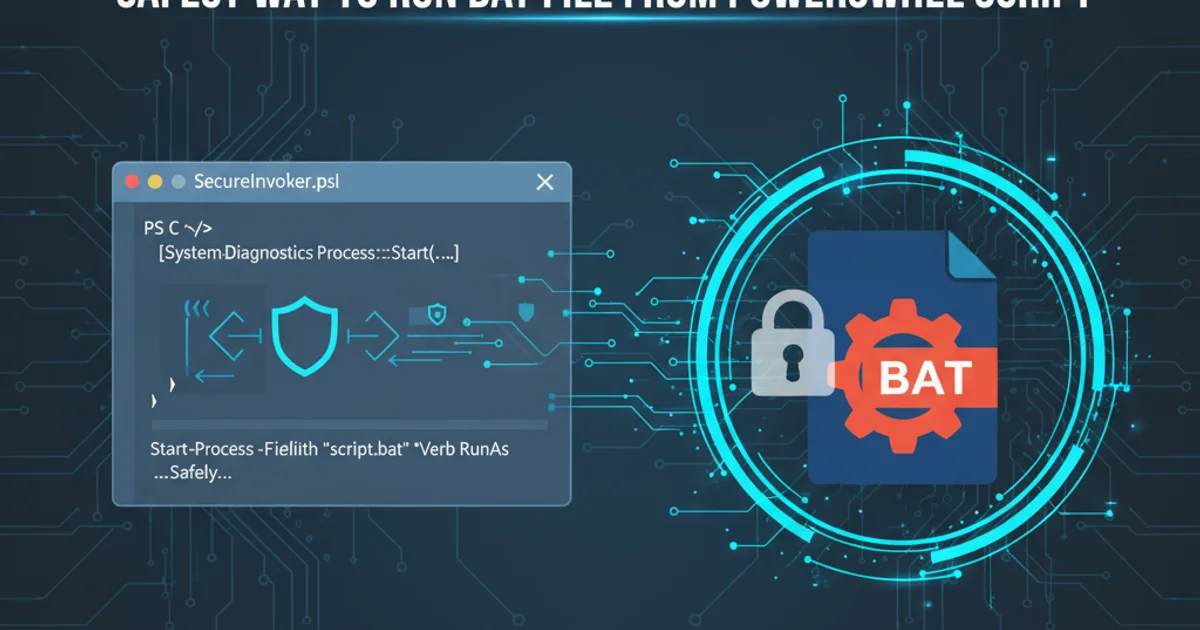Safest way to run BAT file from Powershell script
Categories:
Safely Executing Batch Files from PowerShell Scripts

Learn the most secure and robust methods to invoke legacy batch (.bat) files from PowerShell, ensuring proper error handling, argument passing, and process management.
Integrating legacy systems or scripts written in batch (.bat) files with modern PowerShell automation can be a common requirement. However, simply calling a .bat file directly from PowerShell might lead to unexpected behavior, especially concerning argument parsing, error handling, and process synchronization. This article explores the safest and most reliable ways to execute batch files from PowerShell, focusing on best practices for robustness and security.
Understanding the Challenges
When PowerShell executes a batch file, it essentially launches a new cmd.exe process. The primary challenges arise from how arguments are passed, how cmd.exe interprets them, and how PowerShell captures the exit code and output. Direct invocation can sometimes bypass proper quoting mechanisms or lead to race conditions if not handled carefully. Additionally, batch files often rely on environment variables or specific working directories that need to be correctly set by the calling PowerShell script.
flowchart TD
A[PowerShell Script] --> B{"Invoke Batch File?"}
B -->|Yes| C[Start cmd.exe Process]
C --> D[Pass Arguments Safely]
D --> E[Execute Batch File]
E --> F[Capture Exit Code & Output]
F --> G[Handle Errors]
G --> H[Return to PowerShell]
B -->|No| I[Continue PowerShell Logic]Process Flow for Safely Invoking a Batch File from PowerShell
Method 1: Using Start-Process for Asynchronous Execution
The Start-Process cmdlet is PowerShell's go-to for launching external applications. When used with batch files, it provides excellent control over the process, including the ability to run asynchronously, specify credentials, and redirect output. For synchronous execution, you can use the -Wait parameter. This method is generally preferred for its flexibility and explicit control.
# Example 1: Basic synchronous execution with Start-Process
$batchFile = "C:\Scripts\MyBatch.bat"
$arguments = "/param1 value1 /param2 \"value with spaces\""
Write-Host "Executing batch file: $batchFile with arguments: $arguments"
$process = Start-Process -FilePath cmd.exe -ArgumentList "/c `"$batchFile`" $arguments" -Wait -PassThru -NoNewWindow
if ($process.ExitCode -eq 0) {
Write-Host "Batch file executed successfully."
} else {
Write-Warning "Batch file failed with exit code: $($process.ExitCode)"
}
Synchronous execution of a batch file using Start-Process
/c with cmd.exe to ensure the command is executed and the cmd.exe process terminates afterward. The " around $batchFile is crucial for paths with spaces.Method 2: Direct Invocation with & (Call Operator)
The call operator (&) allows PowerShell to execute a command, script, or executable. While simpler, it requires careful handling of arguments, especially those containing spaces or special characters, as PowerShell performs its own parsing before passing them to cmd.exe. This method is best for simple batch files with few or no complex arguments.
# Example 2: Direct invocation using the call operator
$batchFile = "C:\Scripts\AnotherBatch.bat"
$arg1 = "Hello"
$arg2 = "World with spaces"
Write-Host "Executing batch file: $batchFile with arguments: $arg1, $arg2"
# Using cmd.exe /c to ensure proper execution and exit code capture
$command = "cmd.exe /c `"$batchFile`" `"$arg1`" `"$arg2`""
# Execute and capture output/exit code
$output = Invoke-Expression $command
$exitCode = $LASTEXITCODE
if ($exitCode -eq 0) {
Write-Host "Batch file executed successfully. Output: $output"
} else {
Write-Warning "Batch file failed with exit code: $exitCode. Output: $output"
}
Direct invocation of a batch file using the call operator and Invoke-Expression
Invoke-Expression can be a security risk if the $command string is constructed from untrusted input, as it executes arbitrary code. Prefer Start-Process or direct & invocation with explicit argument lists when possible.Best Practices for Robust Execution
Regardless of the method chosen, several best practices ensure robust and secure execution of batch files from PowerShell:
1. Use Full Paths
Always specify the full path to the batch file to avoid issues with the system's PATH environment variable or current working directory.
2. Quote Arguments Carefully
Arguments containing spaces or special characters must be properly quoted. When passing arguments to cmd.exe, you often need to escape quotes for cmd.exe to interpret them correctly. For example, "value with spaces" becomes \"value with spaces\" when passed as a single argument to cmd.exe via PowerShell.
3. Capture Exit Codes
Batch files communicate success or failure via their exit code. In PowerShell, this is typically available via $LASTEXITCODE after direct invocation or from the ExitCode property of the process object returned by Start-Process -PassThru.
4. Redirect Output
Capture stdout and stderr from the batch file for logging and debugging. Start-Process offers -RedirectStandardOutput and -RedirectStandardError parameters. For direct invocation, output is usually captured directly.
5. Set Working Directory
If the batch file relies on a specific working directory, use the -WorkingDirectory parameter with Start-Process or Set-Location before direct invocation.
6. Error Handling
Implement try/catch blocks around your batch file invocations to gracefully handle unexpected errors or non-zero exit codes.